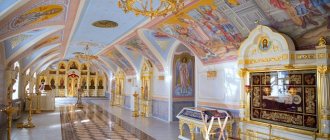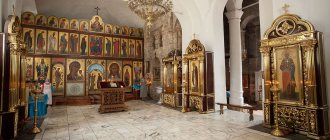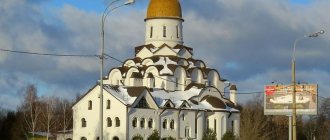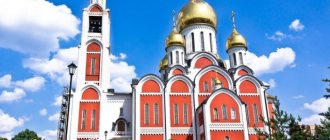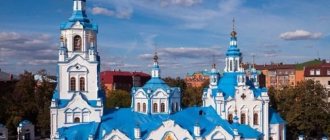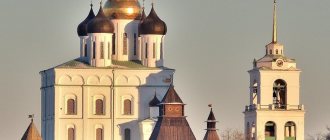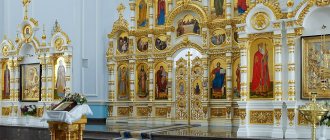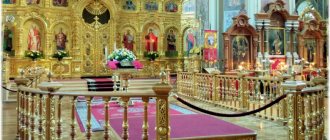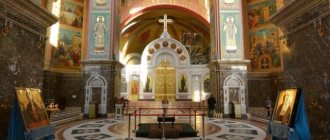Orthodox people often go on pilgrimages to holy places and ancient churches, with rich history, prayerful elders and unique icons. The Minsk Church of the Holy Spirit is a source of filling faith and peace for hundreds of thousands of people. Every person seeking spiritual harmony can enter the temple; its doors are always open to wanderers.
The temple building is majestic both inside and outside. But it wasn't always like this, it has a rich history with some really tough times and events.
brief information
- Founded
in 1633. - Construction
- 1633-1642 - Diocese
- Minsk - Architectural style
- Vilna Baroque - Relics and shrines
- Minsk Icon of the Mother of God, relics of Sophia of Slutsk - Schedule of services:
| Weekdays | 09.00, 18.00 |
| Sunday | 7.00, 10.00, 18.00 |
| Holidays | 7.00, 10.00, 18.00 |
Reliquary with the relics of the Belarusian saint
Church historians note that almost immediately after her death, Sophia began to be revered by the people as the patron saint of sick women preparing to become mothers. The relics turned out to be incorrupt, and miracles happened at the tomb. In 1848, a religious procession with the relics of the saint saved the city from cholera. “Ordinary Orthodox people have been keeping for centuries the legends about the intercession of the blessed Sofia Sluchina. So, according to her prophecy in Slutsk, not a single fire happened on Yuryevskaya Street. When the incorruptible relics of the saint were discovered, the religious procession with them more than once saved the city from epidemics and other disasters. The teacher of the Slutsk Theological Seminary, Hieromonk Markian, in the 18th century, compiled a book: “Miracles of the Blessed Slutsk Princess Sophia Olelkovna, who rests incorruptibly with her relics in the Slutsk Holy Trinity Monastery.” After the war of 1941-1945, on April 3, 1984, the Orthodox Church officially canonized Princess Sophia, canonizing her.
Story
The cathedral building was built in 1633-1642.
as a temple of the Catholic Bernardine monastery.
The stone monastery complex
was built in
1652.
According to the inventory of 1784, almost in this place, but somewhat towards the former Kosmodemyanovskaya (Kozmodemyanovskaya) street there was an Orthodox Kosmodemyanovsky monastery, which at the beginning of the 18th century was forcibly converted into a Uniate one.
In 1741, the Bernardine monastery suffered from a fire, after which it underwent reconstruction. In 1852 the monastery was abolished and transferred to Nesvizh. Since 1860, the former church became an Orthodox church. The building has been rebuilt several times. A U-shaped two-story building adjoins the temple from the northeast. In 1870, after renovation, the temple was illuminated in the name of the Holy Spirit, and in the same year, an Orthodox male monastery was opened with it, which existed until 1922.
After the suppression of the national liberation uprising in 1863, a large group of rebels was kept in the monastery, among whom was the daughter of V. Dunin-Martsinkevich Kamila.
The Cathedral of the Holy Spirit attracts attention because it reminds us of the heavenly world; it is perceived as if there was music that was miraculously embodied in the construction. At a time when much of the surrounding architecture sounds dissonant with this sublime feeling, suppressing our joyful mood, oppressing us with the menacingness of its volumes.
This is the first impression that arises in the soul when meeting the Minsk Cathedral, which rises steeply above Freedom Square.
Born for life by talented craftsmen, whose names we do not know, the temple adorns the historical center of Minsk, architecturally representing a two-tower, three-nave basilica, made in the Vilna (Belarusian) Baroque style.
The place where the Minsk Holy Spirit Cathedral is located has belonged to the Orthodox Church since ancient times. Before the forced introduction of church union in Minsk after 1596, an Orthodox monastery in the name of the unmercenaries Cosmas and Damian was located here. This monastery also owned lands adjacent to the modern cathedral. Information about this historical fact was preserved in the inventory of 1784. In the 16th century it was the eastern outskirts of ancient Minsk. Monastery buildings were one of the structures that had defensive significance.
The first information about this Orthodox monastery dates back to the beginning of the 15th century. It is also mentioned in historical documents of the early 17th century. The Belarusian ethnographer and writer Pavel Shpilevsky, who studied the ancient acts and charters of the Minsk province in the 19th century, points to the existence by the beginning of the 17th century of an Orthodox monastery church - “Kozmodemyanovskaya ...; there was a school with her.” There is also mention in documents of Kozmodemyanovskaya Mountain, on which the Holy Spirit Cathedral now stands.
It should be noted that until the end of the 16th century, the vast majority of churches in Minsk were Orthodox churches. Information has been preserved about the existence in the city from the end of the 11th to the beginning of the 17th century of sixteen monastery and parish churches: the Cathedral of the Nativity of the Blessed Virgin Mary, the St. Nicholas Monastery, the Spaso-Voznesenskaya (monastery), the Holy Spirit (monastery), Kosmo-Damianovskaya (monastery), Resurrection , St. George's, Spaso-Preobrazhenskaya (convent), Petro-Paul (monastery), in the name of Praskeva Pyatnitsa, Boriso-Glebskaya, Holy Trinity, Mikhailovskaya, in the name of St. Euphrosyne and in the name of the Baptist and Baptist John.
A fragment of the banner of the Minsk tailors with images of the defenders of the workshop of the unmercenaries Kosma and Damian. 1830
At the beginning of the 17th century, the property and the Cosmo-Damianovsky monastery itself were illegally confiscated by the Polish authorities from the Orthodox and transferred to the Uniates. The church union was greeted by Orthodox Minsk residents of all classes with displeasure and murmur. The following mass protests of Minsk residents against the church union are documented: March 1, 1597 - a speech by townspeople against the Uniate Metropolitan Michael (Rogoza); in 1612 and 1616, there were also mass protests of townspeople against the Brest Church Union.
Due to the illegal confiscation by the Polish king of all churches and monasteries from the Orthodox population of Minsk, in 1613 the Minsk townspeople established the Peter and Paul Brotherhood (modern Peter and Paul Cathedral on Nemiga). This brotherhood was the largest of the seven Minsk brotherhoods (the cathedral hospital at the castle church of the Nativity of the Virgin, Resurrection, Crusader, St. Michael, St. Nicholas, St. John the Baptist and St. Anne), which waged a constant struggle against the union. Schools, almshouses and printing houses were established under the brotherhoods. In 1620, the Peter-Paul Brotherhood was approved by Patriarch Theophan IV of Jerusalem. By this time (end of the 16th century) about 5 thousand people lived in the city of Minsk. Due to the fact that Minsk residents refused to accept the Brest Church Union and, therefore, refused to visit the churches and monasteries transferred to the Uniates, the Roman Catholic church authorities faced the acute issue of the material maintenance of all real estate confiscated from the Orthodox. Due to the difficulty of resolving it, many former Orthodox churches and monasteries, including the Cosmo-Damianovsky Monastery, were transferred by the Uniates to monastic orders of the Latin Rite of the Roman Catholic Church. This happened in 1633. Thus, the churches and other real estate of the former Orthodox Kosmo-Damianovsky monastery went to the female Roman Catholic order of Bernardines. After some time, a fire occurred in the former monastery, destroying temple and other buildings. Fires during this period were not a rare occurrence in Minsk, causing the local population to suffer. Until the end of the 16th century, the entire building of Minsk was wooden, and only starting from the 17th century, stone buildings began to be erected in many places.
After the fire, in the period from 1633 to 1642, the Bernardine Church (the building of the current cathedral) was erected on the lands of the former Kosmo-Damianovsky Orthodox monastery. The stone monastery complex was built later in 1652.
During the Russian-Polish War (1654-1667), the temple was significantly damaged. Therefore, it is no coincidence that in August 1687 it was consecrated again by Bishop Nikolai Slupsky of Vilna.
Interesting memories about the life of the Bernardine nuns were left by the steward of the Russian Tsar Peter I, P.A. Tolstoy, who in 1697 passed through Minsk: “I was in the monastery of Panen Barnadynok,” he noted, “Barnadynka girls walk in black... they wear thick hair shirts and are belted with ropes with knots, they always step barefoot in winter and summer, and pads, they go to the church using a secret staircase built in the wall, and stand in the choir, looking into the church with small holes through gratings so that people do not see them. Those barnadynkas played the organs in front of me and sang very wonderfully...”
Information has been preserved about what the Bernardine Church looked like at the beginning of the 19th century. On both sides there were small stone chapels. 3 small bells sounded on the towers; on the central pediment (where today we see the mosaic of the icon of the Mother of God) there was a large bell, the entire church was whitewashed, its roof was covered with shingles, and the bell towers were covered with tin. Near the monastery there were a number of buildings for economic purposes.
In 1741, the temple was badly damaged by a fire, after which it underwent reconstruction. Frequent fires were a serious disaster for Minsk. They caused great damage to the city in 1809, 1813, 1822, but the most severe fire broke out on May 30, 1835 during a contract fair. Then the Bernardine convent, the building of a modern cathedral with adjacent buildings, was the first to catch fire. Due to the inaction of the fire brigade, the fire quickly engulfed the entire central part of the city. The fire raged for about 8 hours. The damage caused to the city was truly terrible: many residential buildings and most of the religious buildings were damaged, including the Bernardine convent itself, the gymnasium, and the city theater.
The Bernardine nuns, who suffered from a fire, were unable to restore the temple to its original form, and in 1852, due to a reduction in the number of nuns in it, the temple was closed altogether. The remaining few nuns were transported to the Bernardine monastery in the city of Nesvizh. The Bernardines took all their property, except for the bell left on the pediment of the temple, with them. The temple remained abandoned for some time.
Despite the fact that the property of the Kosmo-Damianovsky Monastery was illegally confiscated by the Polish authorities from the Orthodox and transferred to the Uniates, and then to the Bernardine nuns, who erected their own temple in its place, the people's memory of the Orthodox monastery was preserved for more than three centuries until XX century. This fact is evidenced by the fact that until 1931 the street that went down from Cathedral Square (modern Freedom Square) was called Kozmodemyanovskaya. This street was short and crooked and was considered one of the oldest in Minsk. In ancient times, it ran along the shortest route in the southeast of the city fortress and connected the lower part of Minsk - Zamchishche - with its upper part (it led to the current Holy Spirit Cathedral). Kozmodemyanovskaya Street is marked on the map of Minsk, dated 1793. The plan shows that its borders were the Bernardine Monastery (the modern cathedral) and Nemizskaya Street (then name Nemigi).
In the 18th century, Kozmodemyanovskaya Street was the only one in the city entirely built up with stone houses. It was a unique monument of urban planning of the Renaissance. The narrow, crooked, dark, cobblestone street climbed steeply uphill. It was built up with two- and three-story houses, the first floors of which housed numerous workshops, shops and small shops. In everyday life the street was called “Dark Krams” or “Pamizh Dark Krams”. The proximity to the Low Market also affected Kozmodemyanovskaya’s life. On weekends and holidays, the street was filled with numerous traders of a wide variety of goods. There were also industrial enterprises here.
In 1933, Kozmodemyanovskaya Street was renamed in honor of the Soviet poet and writer Demyan Bedny (real name Efim Alekseevich Pridvorov).
Kozmodemyanovskaya street, 1931.
Before the war, Kozmodemyanovskaya Street (since 1933 D. Bedny) still retained its appearance. However, during the Great Patriotic War, fascist bombing turned the street into ruins. Complete traces of the street disappeared in 1989 due to the construction of the Nemiga metro station. Not a trace remains of the former Kozmodemyanovskaya Street...
Until 1860, the building of the former Bernardine convent (the modern Cathedral of the Holy Spirit) was empty. This year the temple was returned to the Orthodox Church, minor repairs were made to it, and it was consecrated in memory of Equal-to-the-Apostles Methodius and Cyril. Over the next few years, services were held in the church for students of the Theological Seminary, transferred from Slutsk to Minsk. The seminarians lived in neighboring monastery buildings. Thus, after more than 250 years, historical justice has triumphed, and the lands of the Kosmo-Damianovsky Monastery, which was once illegally taken from the Orthodox Minsk residents, were returned to its former and legal owner - the Orthodox Church.
View of Minsk. One of the first photos of the city. 1863. The photograph was published in the magazine “Photographic Illustration”, 1863, No. 8-9. (Source: “History of Belarusian books”, vol. 2, p. 104).
At the end of the 60s of the 19th century, the temple looked very bad, which is why it required major repairs. You can imagine the state of the church at that time by reading the report sent to the diocesan authorities from Peter Elinovsky, archpriest of the Minsk Peter and Paul Cathedral. “Upon a careful examination of the Cyril and Methodius Church,” wrote Archpriest P. Elinovsky, “I found that the building was in the most pitiful condition... It was on fire on May 30, 1835 and November 30, 1852. After the fire, the roof was built first of wood, and the second of iron, but the exterior of the church has not been repaired since 1825, and the bell towers were not covered either after the first or after the second fire.”
A special role in the history of the temple was played by Archbishop of Minsk and Bobruisk (Turov) Alexander (Dobrynin) (1868-1877). He was a comprehensively educated man, brought up under the direct guidance of the ever-memorable Metropolitan of Lithuania and Vilna Joseph (Semashko). Since 1879, he became a worthy successor to the outstanding and zealous metropolitan pastors Joseph (Semashko) and Macarius (Bulgakov) at the Lithuanian See. To strengthen Orthodoxy in Belarus and Lithuania, he built and personally consecrated churches, opened new ones and renewed old brotherhoods. Thanks to his efforts and concerns, many churches and parishes in the region were provided with land and buildings. This activity, in connection with the remarkable personal qualities of Archbishop Alexander - meekness, cordiality, simplicity and friendliness in communication, as well as accessibility for everyone and religiosity, accompanied by deeds of love and mercy, left a deep memory for him among the population of the Minsk and Vilna provinces.
His Eminence Alexander (Dobrynin), Archbishop of Minsk and Bobruisk (Turov) (1868-1877), Lithuanian and Vilna (1879-1885).
In 1869, at the request of Archbishop Alexander (Dobrynin), the necessary funds were allocated from the treasury to bring the temple and the adjacent building into proper order in order to open a male Orthodox monastery here. An amount of 13 thousand rubles was allocated (a very significant amount at that time), half of which was used to repair the temple and install a new iconostasis in it.
Archpriest P. Elinovsky was recognized as responsible for the repair of the church. Taking on this complex task, he carried out major repairs. Under his leadership, not only the temple itself was restored, but also the monastery building.
Restoration of the cathedral at the end of the twentieth century.
The opening of the monastery took place on January 4, 1870, and in May there was an order from the Synod to call it the Holy Spiritual Monastery. The consecration of the main altar of the monastery church in honor of the Descent of the Holy Spirit took place on October 22, 1870, and on November 1 of the same year the right aisle of the church was consecrated in honor of Saints Methodius and Cyril.
The brethren were made up of monks of the ancient Slutsk Holy Trinity Monastery. Its library, sacristy and much other monastic property were transferred to Minsk. The monks who arrived from Slutsk were greeted festively. Bishop Alexander (Dobrynin) of Minsk blessed the monks with an icon of the Vilna martyrs - Anthony, John and Eustathius. An icon of the Dormition of the Blessed Virgin Mary was also sent from the Kiev Pechersk Lavra as a blessing, a copy of the miraculous icon that had been preserved in the famous Kiev monastery since ancient times.
The monks who came from the Slutsk Holy Trinity Monastery, as a dear memory to them, “placed on the throne” of the Holy Spiritual Church the ancient Gospel, personally rewritten in 1582 by the Orthodox Prince Yuri II Yuryevich Olelko. On the silver cover of that Gospel there was an inscription: “in the name of the Most Holy and Life-Giving Trinity of the Father and the Son and the Holy Spirit: this holy Gospel is inscribed by the authoritative hand of Yuri Yuryevich Olelko, Prince of Slutsk from R.H. June 1582 4 days and gave eternal hours, until the Holy Trinity, to the pious Archimandria of Slutsk, for eternal prayer and salvation of his soul in the unforgettable memory, like the ancestors of our Princes of Slutsk and parents and himself. Summer 1584.”
Yuri Yuryevich II Olelkovich, Prince of Slutsk and Kopyl (August 17, 1559 – May 6, 1586), father of Righteous Sophia of Slutsk
In addition to the Slutsk Gospel, other shrines were kept in the Holy Spirit Church, among which was the icon of St. Nikita, Bishop of Novgorod, with a particle of his relics; a lifetime portrait of St. Tikhon of Zadonsk, four silver-plated crosses that served as reliquaries for relics. The inscription on one of the crosses testified that the crosses contained particles of the holy relics of many saints of God.
The Holy Spirit Church operated until the beginning of 1918 and was a monastery. In 1905, the number of inhabitants of the monastery did not exceed ten. Among them there was one archimandrite, one abbot, four hieromonks, two hierodeacons and two monks. There was a vocational school at the monastery, where orphans learned the craft of carpentry.
View of the High Market from Trinity Mountain. From fig. Ya. Drozdovich. 1919
In 1914-1916, services in the church were often conducted by His Grace Theophylact (Klementyev), Bishop of Slutsk, vicar of the Minsk diocese, who in 1917 went to the Local Council in Moscow. After Theophylact, for a short time Archimandrite Afanasy (Vecherka) served as rector of the temple, who authored an interesting book about Righteous Sophia, Princess of Slutsk and Kopyl, whose incorrupt relics are still preserved in the cathedral. This book was published in Minsk in 1912 and is a bibliographic rarity.
In 1918, after the Bolsheviks came to power, the monastery was closed, and soon services in the Holy Spirit Church ceased. After this, much of the church utensils disappeared without a trace. In the temple itself, the new authorities ordered the construction of a gym for the fire brigade, and then an archive. According to some evidence, the crypt part of the temple in the late 1920s – early 1930s was adapted into a transit prison in which “dispossessed” peasants were kept. As Minsk guards testify, the new owners of the temple removed the crosses from the cathedral towers and hoisted red flags in their place. However, gusts of wind tore them off and threw them down.
The story has been preserved that in Soviet times the building of the Holy Spirit Cathedral was saved from destruction only by a miracle. In 1938, the city's population was herded to its walls for a rally. To create an appropriate setting, a fire was built near the entrance, where religious literature was burned. To congratulate the workers, a speaker rose to the podium and vowed not to leave his place if the temple was not destroyed. But, while descending from the stands, he tripped and broke both legs. And when the next day the wind tore the red flags that were hung instead of crosses from the towers, the Bolsheviks considered it best not to touch the building.
After the confiscation of the Holy Spiritual Church from Orthodox believers, its iconostasis was dismantled and moved for preservation to the Spaso-Preobrazhensky convent, which was located on the site where the buildings of the General Prosecutor's Office and the Pobeda cinema are currently located. From here, in 1921, this iconostasis ended up in the parish church of the village of Prilepy, which is located near Minsk. There he was gathered again and consecrated on Palm Sunday. Along with the iconostasis, some more icons that were previously in the Holy Spirit Church were transported to Prilepy. Among them, the following stood out: the altar icon of the Most Holy Trinity, the icons of Equal-to-the-Apostles Methodius and Cyril, the unribbed Cosmas and Damian, the great martyr and healer Panteleimon, the great martyr Barbara, the apostle archdeacon and the first martyr Stephen. All of them were destroyed in the 30s during the closure of the temple in Prilepy...
During the Great Patriotic War, services in the Holy Spirit Church were resumed. The consecration of the church was performed by His Grace Philotheus (Narko), Bishop of Mogilev and Mstislav. According to the design of engineer Anton Yakovlevich Vasiliev, at the beginning of 1943, a new three-tier iconostasis was installed in the church (dismantled in 1961). One city resident became a donor to the cathedral, who provided funds for the repair of the cathedral, which he received from the sale of two of his own houses.
View of the temple during the Great Patriotic War (1941-1943).
Simultaneously with the temple, the Holy Spirit Monastery was revived, in which three monks lived. Hegumen Panteleimon (surname unknown) served as rector of the church during wartime. Hieromonk Julian (Trotsky) helped him. Later they were joined by Archimandrite Seraphim (Shahmud) (1901-1946), and in 1943 he was appointed rector of the Holy Spirit Church. Archimandrite Seraphim was widely known because he took part in the opening of many churches during the war. In Minsk, Father Seraphim took voluntary care of the city's hospitals, nursing homes and orphanages. He could often be seen visiting people destitute by the war. He performed his pastoral duty strictly and strictly. In 1944, with the arrival of the Red Army, he was arrested. During interrogations, the arrested clergyman behaved with courage. Without hiding his views from the “investigator,” Archimandrite Seraphim, when asked what he said during sermons when he traveled around Belarus, directly said that he often addressed the people with approximately the following words: “Russia was a believer. Our ancestors, grandfathers, great-grandfathers, fathers believed, and now we will live happily again through faith. It’s not good that the atheists closed our shrines, that your fathers and mothers died without the guidance of the Holy Mysteries and were buried without a priest, and that your children grew up not baptized and were not married...” In 1946, the holy martyr died while imprisoned in a prison of the NKVD of the USSR. In 2000, he was canonized as one of the holy new martyrs and confessors of the Russian Church of the 20th century.
Venerable Martyr Archimandrite Seraphim (Shahmud), commemorated August 6 (NS).
The next rector of the Holy Spirit Cathedral, Archpriest Seraphim Stefanovich Batorevich, was also arrested in 1951 and sentenced to 25 years in prison. Archpriest S. Batorevich was the rector of the Minsk Holy Spirit Cathedral from 1947 to 1951. At the same time, he served as dean of the parishes of the city of Minsk and diocesan secretary. According to the recollections of parishioners, Archpriest S. Batorevich performed divine services reverently and zealously. He was a wonderful preacher, possessed artistic and singing gifts, treated his flock with love and was dearly loved by his parishioners. He died on April 21, 1960, on Easter, from the effects of radiation sickness received in prison.
After its opening in 1942, the Holy Spirit Church never closed. In 1945, an ancient shrine was brought from the closed Peter and Paul Cathedral into the Holy Spirit Church - the miraculous Minsk Icon of the Blessed Virgin Mary. In 1947, crosses were erected over the cathedral. In the first half of the 1950s, a major overhaul of the interior of the temple was carried out, for which a significant sum of 500 thousand rubles at that time was spent.
In 1953, on the northern side of the temple, a chapel was built in honor of the Great Martyr Barbara, in which a particle of the holy relics of this saint was placed. In 1968, a throne in honor of the Kazan Icon of the Mother of God was established in the southern aisle of the cathedral. At the northern wall of the temple there is a shrine with the relics of Righteous Sophia, Princess of Slutsk, and in the crypt part of the cathedral there is a chapel in honor of Equal-to-the-Apostles Methodius and Cyril, which acts as a baptismal church.
Since 1961, the Holy Spirit Church was given the status of the cathedral of the Minsk diocese.
During Soviet times
The cathedral was closed in the first years of Soviet power. Believers were able to resume worship there only under the conditions of the German occupation of Belarus. The cathedral, prepared for the service, was consecrated by Bishop Philotheus (Narco). Almost immediately after the liberation of Minsk, the Soviet authorities closed the main Orthodox church of the city, the Peter and Paul Cathedral, which also began to operate again during the years of occupation, and thus the Holy Spirit Cathedral became the cathedral church of the Minsk diocese.
How to get to the Holy Spirit Cathedral in Minsk
Detailed information on how to get to the Holy Spirit Cathedral is presented below.
By public transport:
from Art. Nemiga metro station, walk 400 meters to the cathedral.
By car:
- From Oktyabrskaya Square along Avenue. Independence towards GUM, after 160 m to the right, onto the street. Engelsa, then left, onto the street. International and to the right, to the Holy Spirit Cathedral.
- From the Moscow Ring Road (0th kilometer) to Ave. Independence, after 8.7 km to the right, on the street. Engels, at the first intersection turn left, onto the street. International and to the right, towards the cathedral.
Miraculous Icon of the Mother of God
The most valuable relic
- the miraculous icon of the Mother of God, found by Minsk residents in 1500 and called Minsk.
The history of this wondrous image dates back to Gospel times. According to legend, the holy apostle and evangelist Luke wrote it, among many others .
For many centuries it was in Byzantium. More than a thousand years ago, on the eve of the Baptism of Rus', a list from it was brought to his homeland by the holy Equal-to-the-Apostles Prince Vladimir and installed it in the Tithe Church, built in the 10th century. For five centuries this icon was in Kyiv. In the XY century. During the Tatar invasion of Kyiv, the Tatar threw the icon into the Dnieper, removing its decorations.
But the icon of the Mother of God survived and after some time appeared in Minsk on the Svisloch River opposite the castle, where, due to its “extraordinary radiance, it was noticed by the inhabitants of the city on August 13, 1500.”
was taken and placed in the castle Church of the Nativity of the Virgin Mary and remained there for 116 years” (in the Lower Castle of Minsk, in the Cathedral Church of the Nativity of the Blessed Virgin Mary). Since 1616, the icon was in the Uniate Church of the Holy Spirit, part of the complex of the Basilian monastery (from the end of the 18th century - the Peter and Paul Orthodox Cathedral). From the 1920s, the icon was kept in the museum until it was transferred to the current Cathedral of the Holy Spirit. (During the war, the icon was in the Peter and Paul Cathedral).
In honor of the appearance of the icon of the Mother of God in our city, a solemn service and Divine Liturgy are held annually, led by Metropolitan Philaret of Minsk and Slutsk, Patriarchal Exarch of All Belarus.
Be sure to visit the Holy Spirit Cathedral with a tour!
Only a professional guide will be happy to introduce you to the secrets of the construction and history of the Cathedral of the Holy Spirit in Minsk. Together with him you will see all the sights of Minsk and walk along its streets, learning a lot about the capital of Belarus. Our sightseeing tours of Minsk will allow you to see the city in a different light:
- an evening tour of Minsk will introduce you to the beauty of the city in the pre-sunset hour,
- An individual excursion with a private guide will allow you to enjoy the beauty of Minsk without depending on a group of other tourists.
Today, the Cathedral of the Holy Spirit serves as a kind of spiritual pearl of the central part of Minsk. Walking around Nemiga, you willy-nilly admire the perfectly preserved building, which has such an amazing history and has absorbed so many shrines. And it is definitely worth visiting the cathedral at least once during regular services.
Service Schedule
Divine services are held daily in the Holy Spirit Cathedral. On weekdays and Saturdays the service begins at 8.40. Mass begins at 9.00.
All changes to the schedule can be tracked on the official website of the cathedral - sabor.by
On Sundays, as well as on the days of the temple, great and twelve feasts, two Divine Liturgies are held - early and late. Services begin at 7 and 10 am respectively. Those wishing to confess must come half an hour before the start of the liturgy. Every day, except Sunday, akathists are sung at 17.00. Evening services begin at 18:00.
Cathedral on the map of Minsk
Life of the Cathedral
The location of this cathedral is located where there used to be a monastery, built at the beginning of the 8th century. Construction work on its construction took almost 10 years. When all the construction work was completed, it looked like a monastic complex.
The temple itself has gone through many trials. These include numerous fires and other tests. After which work was carried out on its reconstruction. There were also times when the church building was considered ownerless and no services were held in it. In 1860, services began to be held there again for both the population and students of the theological seminary.
The best article for you, go to: Holy Trinity Izmailovsky Cathedral St. Petersburg
Over time, major renovations began to be carried out in the temple. It lasted a little over five years. After its completion, two thrones were consecrated. One in honor of Cyril and Methodius, and the other in honor of the Descent of the Holy Spirit on the Apostles. Divine services were held in the temple until 1918, then it was closed by the Bolsheviks. During the well-known struggle of the Bolsheviks against the Orthodox religion, the temple building was used both as a sports hall and as a prison for rich peasants.
Before the Second World War, a meeting was held on the issue of demolishing the church building. One of the speakers demanded that the temple be demolished. He said that he would not leave that place until he saw that the temple was being demolished. But a real miracle happened: he was taken away from the rally because he stumbled on the podium and fell. The result of this fall was the fracture of both legs.
Thus, the Minsk Holy Spirit Cathedral was saved. And in 1942 it reopened to receive parishioners. During the hostilities, the clergy of the cathedral helped all the people who needed it. Today the temple is active and attracts a considerable number of Orthodox believers.
Modernity of the cathedral
In the eighties of the last century, very enlightened people served in the local diocese, in particular, priest Grushetsky. Today he is one of the most revered church ministers of the Minsk Cathedral.
Grushetsky took part in the celebration of the Millennium of the Baptism of Rus', and began to conduct the first religious processions after a long oblivion. The relics of St. were transferred from the Holy Spirit Church to the new church. Mary Magdalene.
